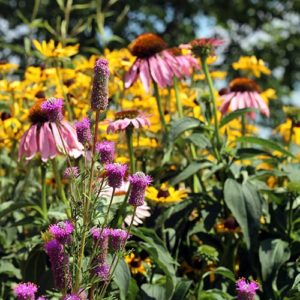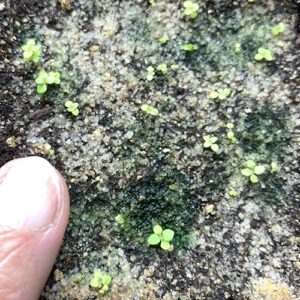Growing native plants is one of the best things you can do to attract pollinators and wildlife. However, if you’ve ever grown native plants either in your garden or in a larger pollinator planting, then you may have noticed that some species are very slow to take off. In fact, the phrase, “The first year they sleep. The second year they creep. The third year they leap,” is commonly used to describe the growth habits of many native plants. But what does that really mean?

Native Plant Growth Habits
Many of our native plants, especially the herbaceous forbs or wildflowers, will only put out a little vegetative growth during their first year and often that will stay relatively close to the ground. That relatively small amount of vegetative growth is what led to the saying that they “sleep” during the first year. The second year they will often put out more vegetative growth and may or may not flower depending on the species. (Compared to their first year, their growth is creeping instead of appearing to sleep.) The third year is often when they appear to really take off or “leap” and seem to come into their own. However, all of that focuses on just what we can easily see – the vegetative parts of the plant.
Only focusing on what we can see is very misleading when it comes to what the plant is actually doing. In reality, the plants aren’t “sleeping” during their first year. Instead, they are putting most of their energy into growing a strong root system. The only role of the vegetation that first year is to collect enough sunlight to convert into energy to fuel the root growth. The second year, the root system is large enough that it needs more vegetative growth to fuel it, thus the additional growth seen during the second year. By the third year, the plants generally have a good strong root system and are ready to begin putting energy not just into root growth or vegetative growth, but also into reproduction (in other words flowers and seeds).
Exceptions to Rule

While the phrase, “The first year they sleep. The second year they creep. The third year they leap,” is commonly used to refer to all native plants, it is actually a very broad generalization. Some species, like black-eyed susan (Rudbeckia hirta) will commonly flower their first year even though they are perennials. Others, like purple coneflower (Echinacea purpurea) typically bloom in their second year. Still others, like wild blue indigo (Baptisia australis) frequently take 3-4 years before they will flower. And then there are others, especially when you move into the shrubs, which just make me shake my head and wonder how they ever survive in the wild because they stay so tiny for so long.
Summary
When growing native plants from seed, it is important to be patient and understand that just because you aren’t seeing a lot of growth to start with doesn’t mean nothing is happening. Remember, that first year or two they are often trying to put most of their energy into establishing a strong root system. Giving them that time will result in a stronger and healthier plant in the long run.

Backyard Ecology: Exploring Nature in Your Backyard
Nature isn’t just “out there.” It’s all around us, including right outside our doors. Hi, my name is Shannon Trimboli, and I am the host of Backyard Ecology. I live in southcentral Kentucky and am a wildlife biologist, educator, author, beekeeper, and owner of a nursery specializing in plants for pollinators and wildlife conservation. I invite you to join me as we ignite our curiosity and natural wonder, explore our yards and communities, and improve our local pollinator and wildlife habitat. Learn more or subscribe to my email list at www.backyardecology.net.

Leave a Reply